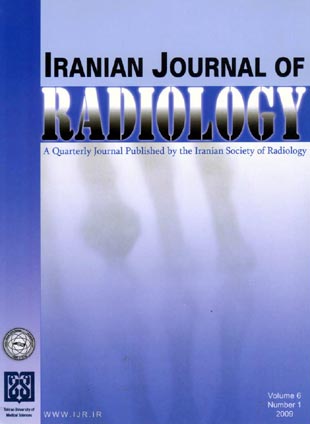فهرست مطالب

Iranian Journal of Radiology
Volume:6 Issue: 1, Autum 2009
- 60 صفحه،
- تاریخ انتشار: 1388/02/01
- تعداد عناوین: 11
-
-
Page 1Acute appendicitis is one of the most common causes of acute abdomen which usually presents with right lower abdominal pain. Although physicians have enough information about this disease, its atypical presentations occasionally become challenging. Nowadays, the role of spiral computed tomography (CT) scan—as a diagnostic modality for lowering the rate of negative appendectomy and ruling out differential diagnoses—is increasing. In this pictorial essay, we describe abdominal spiral CT findings of patients presented with complicated appendicitis to our emergency unit during a two-year period.
-
Page 7Background/ObjectiveWe evaluated the diagnostic accuracy of ultrasonography and conventional radiography compared to clinical examination as the gold-standard technique to determine whether ultrasonography can be the primary diagnostic method for the evaluation of nasal bone fracture.Patients andMethodsThe conventional Waters and lateral nasal bone view radiography and high resolution ultrasonography of 171 patients (128 men, 43 women; mean±SD age, 24±8 years) with a clinical or forensic indication for the evaluation of nasal bone fracture wereinvestigated. The negative likelihood ratio (LR-), positive likelihood ratio (LR+), specificity (Sp) and sensitivity (Se) were used for determining the diagnostic accuracy. The negative predictive value (NPV) and the positive predictive value (PPV) were also determined.ResultsOf 103 fracture lines in patients with a clinically diagnosed nasal bone fracture, conventional radiography detected 80, while ultrasonography detected 90 fractures. The Se of ultrasonography and conventional radiography was 90.2% and 77.6%, respectively; the Sp was 98.5% and 82%, respectively.ConclusionHigh-resolution ultrasonography can be used as an accurate technique for evaluating nasal bone fracture. Conventional radiography can be replaced by high-resolution ultrasonograhy.
-
Page 12
-
Page 13Brucellosis is a common and serious infectious disease in many parts of the world. Skeletalcomplications are reported in the majority of cases with Brucellosis and include arthritis,spondylitis, osteomyelitis, tenosynovitis, and bursitis. Pubic bone involvement is very rare inBrucellosis and there are only two case reports in the literature. We here report two patients with osteomyelitis of the pubic bones due to Brucellosis.
-
Page 18
-
Page 19Neuroenteric cysts are rare congenital anomalies derived from the displaced endodermal tissue around the third week of the embryonic stage. We report a case of neuroenteric cyst of the spinal canal presenting with paraplegia in a 2.5-year-old boy.Despite the 12-day delay in surgical decompression, he made a complete neurological recovery.This is a unique case in regard to the clinical presentation, MRI findings and the excellent outcome after surgery.
-
Page 23Background/ObjectiveThe dose distribution is affected by tissue inhomogeneities. The objective of this study was a dosimetric evaluation of the potential corrective role of computed tomography (CT) data in radiotherapy treatment planning (RTP) for various anatomical sites of the body (head and neck, abdominopelvis and thorax), separately.Patients andMethodsFifty-four cases of head and neck, pelvis, abdomen and breast cancers were included in this study. All of the patients were scanned with the same CT machine.Each case was planned with and without CT-based density correction by a two-dimensional ALFARD RTP system. Analyses of dosimetric parameters were performed for with and without inhomogeneity corrections based on the effective path length method. Dosimetric parameters were dose uniformity (Te), the average (Davg), minimum (Dmin) and maximum (Dmax) doses for both the planning target volumes and organs at risk. These parameters with and without CT-based density correction were compared in the head and neck, abdominopelvic and thoracic regions, separately.ResultsThe mean difference of Te and Davg between these two methods was statistically significant in the thoracic region (7.13±5.55; p=0.001 for Te and 4.65± 6.59; p=0.04 for Davg). Measurements of Te, Davg, Dmin and Dmax in the head and neck and abdominopelvic regions showed no statistically significant differences between the two methods (all p values ≥0.05).
-
Page 29Background/ObjectiveDoppler ultrasonography can be an effective method to assessthe severity of diabetic nephropathy. This study was conducted to investigate the relationship between Doppler ultrasound resistive index (RI) values and the clinical andlaboratory findings in patients with diabetic nephropathy.Patients andMethodsDoppler ultrasound was performed for 45 patients with type IIdiabetes mellitus and 30 healthy controls. Clinical and laboratory findings of cases andcontrols were also recorded.ResultsDiabetic patients were categorized into 3 groups according to the severity oftheir nephropathy, based on the serum creatinine level and 24-hour urine protein. Themean±SD RI was 0.59±0.03 for the control group, 0.67±0.04 for stage I, 0.73±0.02for stage II, and 0.85±0.07 for stage III diabetic nephropathy (p<0.001). RI was significantly associated with the 24-hour urine protein and creatinine (R2=0.75 and =0.67, respectively; p<0.001) and a suitable regression model was adopted to predict the 24- hour urine protein and serum creatinine level based on RI.DiscussionRI increases with the progression of diabetic nephropathy. RI can be used forestimation of the 24-hour urine protein and serum creatinine and for determining thestage of nephropathy, especially for patients not cooperating for collection of the 24-hour urine protein.
-
Bilateral Endometrial Stromal Sarcoma Originating from Ovarian Endometriosis: A Case Report p. 33-36Page 33Endometrial stromal sarcomas usually develop in the uterine corpus and occasionally arise invarious extrauterine sites. Endometriosis is one of the most common benign gynecologicconditions. Malignant transformation is a rare but well-documented complication of endometriosis, occurring in 0.7% to 1% of cases. It can be the cause of some rare malignant tumors like endometrial stromal sarcoma, which is extremely rare at various extrauterine sites. Herein, we describe a surgicaly-proven case of bilateral endometrial stromal sarcoma originating from ovarian endometriosis in a 57-year-old woman.
-
Page 37Pseudoaneurysm of the internal maxillary artery (IMPA) is rare. We presented a 5-year-oldgirl with a mass in the right parotid area, one week after trauma. It was increasing progressively in size. Doppler sonography, computed tomography (CT), angiography and observation during surgery revealed pseudoaneurysm of the internal maxillary artery.


